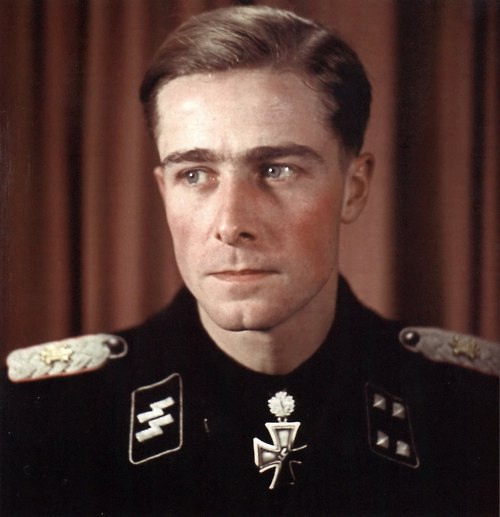German Waffen-Schutzstaffel (Waffen-SS) officer. Born in Berlin on 30 January 1915, Joachim Peiper came from a military family. He was well educated and was fluent in both English and French. Peiper joined first the Hitler Youth, then the SS. Commissioned in the SS in 1936, he served on Heinrich Himmler’s personal staff but sought a combat command. He was a company commander in the elite SS Liebestandarte Adolf Hitler (LAH) in the invasion of the France and the Low Countries in May 1940 and led an abortive effort to seize bridges over the Meuse. He served in the LAH in the invasion of the Soviet Union in June 1941. There his unit was noted for its military efficiency and for its extreme brutality; it was involved in massacring the inhabitants of several villages. Transferred to Italy, in September 1943 Peiper’s troops destroyed the town of Boves and murdered its inhabitants.
After the LAH transferred to France, Peiper studied techniques for night movements that were later used effectively in the Ardennes Offensive (the Battle of the Bulge) in December 1944. In that offensive, SS-Obersturmbannführer Peiper headed Kampfgruppe (battle group) Peiper, which was the lead element for the 1st SS Panzer Division, itself the weighted thrust (Schwerpunkt) for the entire Sixth Panzer Army. Peiper’s mission was to race ahead of the main body of the division, bypass all determined resistance, and capture the bridges across the Meuse River at the small Belgian village of Huy. This would allow following forces to cross this major water obstacle en route to their planned envelopment of the Allied armies to the north.
Despite its experience and the initial disordered nature of the U.S. defenses, Kampfgruppe Peiper never achieved its objective, being thwarted in Huy on 20 December by a determined defense by U.S. Army combat engineers. After several determined efforts to break through failed, on 23 December Peiper and his 800 remaining men abandoned their equipment and retreated on foot under cover of darkness. Before then, Peiper’s unit had already committed one of the most infamous massacres of the war, at Malmédy.
On 17 December, Peiper’s lead elements had overrun a U.S. unit, Battery B of the 285th Field Artillery Observation Battalion. The lead element (with Peiper present) rapidly disarmed the hapless Americans and passed them along to following forces. The soldiers of these trailing units within Peiper’s Kampfgruppe herded the roughly 150 prisoners into a field and then opened fire on them with machine guns and small arms, killing 83 and wounding others.
For this atrocity at Malmédy, Peiper and 69 others were tried before a U.S. military court at Dachau in the spring of 1946. On 16 July 1946, the tribunal condemned Peiper and 43 others to death, although the sentences were subsequently reduced to life in prison. Peiper was later released. On 14 July 1976, Peiper’s house in the small village of Traves, France, burned in mysterious circumstances, reputedly firebombed. Although Peiper’s body was never recovered, he was declared dead.
